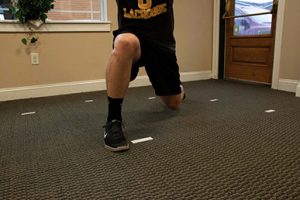Physical Therapy
Physical therapy
Physical therapy is important because we can explain to the patient that the knee is one of the strongest and most important joints in the body. The knee jointis vital for individuals to participate in daily activities, such as walking, running, sitting and standing. The knee joint consists of 3 bones; the femur (thigh bone), the patella (knee cap) and the tibia (lower leg bone). These bones all work together with the assistance of the surrounding muscles, like the quadriceps and hamstrings, to allow for the knee to bend and straighten, or flex and extend. Located inside of the knee joint are cartilage (medical and lateral meniscus) and ligaments (ACL and PCL) that provide the joint with cushioning and stability. The knee joint can withstand excess forces, like running or jumping but, may also lead to injury. Some of these injuries include: meniscus tear, ACL tear or tendinitis.
Common symptoms and complaints:
– Swelling
– Stiffness
– Locking/catching sensation
– Weakness/buckling/giving out
– Popping and cracking
– Decrease motion
Treatment:
– Strength training
– Laser
– Ultrasound
– Massage
– Manipulation
– Muscle retraining
– Stability training
The job of a physical therapist is not only to rehabilitate your ACL but, to get you back to your specific activity as quickly and safely as possible. If you injure your ACL during sport activity or normal activities of daily living our doctor specific protocols are designed to get you back to activities fast. Knowing that the knee is one of the strongest and most important joints of the body our carefully instructed protocols consist of PRE-HABILITATION to carefully guide you before surgery and prevent further injury. SURGICAL RECOVERY that consist of advancing range of motion, reducing swelling, regaining muscle size, strength training and eliminating fear and instability. And finally RETURN TO ACTIVITY whether that activity is sports, outdoors man, ship or back to normal walking for enjoyment. Our protocols are tailored specifically to you.
The foot is a very complex structure that is composed of 26 bones that must work together with
the ankle joint to maintain strength, stability and motion. The complex structure of the ankle
consists of a web of ligaments, muscles and tendons that surround the ankle joint and very
tough muscle at the bottom of the foot to help with weight bearing. Ankle and foot injuries
maybe chronic and are usually complicated due to the constant activity and lack of rest the
ankle and foot must endure.
Common symptoms and complications:
– Pain
– Less of motion/decrease mobility
– Difficulty walking
– Swelling
– Giving out
Treatment
– Taping
– Strengthening
– Stretching
– Electric Stimulation
– Stability
– Agility drills
Laser/light or Anodyne-type Therapy uses light to diminish and eliminate a variety of symptoms associated with circulation issues. Some of the symptoms and complaints associated with circulation issues commonly include pain, loss of balance, and decreased sensation, all of which can greatly dimish the patient’s quality of life. During treatment, infrared light that is not visible to the human eye is applied to the effected area. The infrared light is able to penetrate 3-5 centimeters into the tissue releasing nitric oxide which causes vasodilation (relaxation of smooth muscle cells within vessel walls). Vasodilation increases blood flow to the area which decreases the patient’s pain and increases balance and sensation.
Common symptoms or complaints:
- Poor circulation
- Loss of balance
- Increased pain
- Decreased sensation
- Diminished quality of life
How Laser/light Therapy works:
- Infrared light penetrates tissue, creating a reaction causing vasodilation
- Vasodilation increases blood flow which can decrease or eliminate symptoms
https://www.ncbi.nlm.nih.gov/pmc/articles/PMC4766069/
 https://robertberkleyphysicaltherapy.com/laser-anodyne-type-therapy/
https://robertberkleyphysicaltherapy.com/laser-anodyne-type-therapy/

